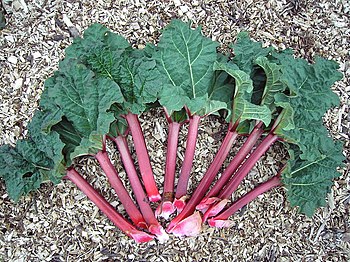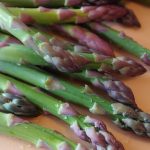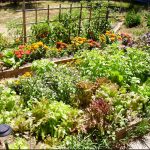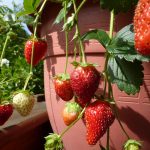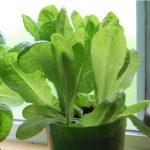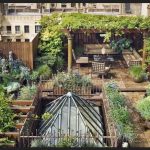7 Fruits and Vegetables that You Can Grow in an Apartment
Table of Contents
Don’t settle for a few herbs in your windowsill when you can have these seven crops that thrive in container gardens that you can have right in your apartment!
1. Strawberries
Any of the ever-bearing or June-bearing varieties work well in containers, so long as they have about 6 hours of sunlight. One of the favorite varieties of indoor gardeners is the Alpine strawberry. If you are keeping them strictly indoors, you can plant any time of the year. If you are planting outdoors, it’s best to plant them in the early spring if you get cold winters, or in the fall if you have mild winters.
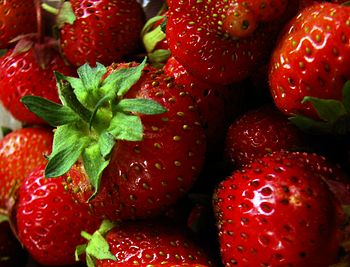 Starting from seed can be difficult and frustrating, which is why most experts recommend getting transplants. To plant them, trim the roots to 5 inches, then soak them in water for about an hour before planting. Because they have a shallow root system, they can easily live and thrive in nearly any size or depth of container. Just be sure to keep the bud crowns at the level of the soil when planting.
Starting from seed can be difficult and frustrating, which is why most experts recommend getting transplants. To plant them, trim the roots to 5 inches, then soak them in water for about an hour before planting. Because they have a shallow root system, they can easily live and thrive in nearly any size or depth of container. Just be sure to keep the bud crowns at the level of the soil when planting.
During the first six weeks, you should cut off any blossoms that appear to encourage your plants to put their energy into making fruit rather than reproducing. Then, begin to fertilize the flowering plants once every ten days. They need to be watered daily during their growing season.
2. Rhubarb
Although it won’t thrive as well in a bed as it does in a container, you can still plant rhubarb indoors with success. To provide space for their long root system, plant them in a container at least 12 inches across that is about twice as deep. With rhubarb, drainage is particularly important, so add extra drainage holes if necessary.
When you begin your rhubarb will depend on the variety that you are planting, so be sure to check to see when you need to start yours. The crown needs to be planted from 1 to 3 inches beneath the surface of the soil. Rhubarb needs at least six hours of sunlight every day, and does well sitting outside if you are in hardiness zones 3 through 8.
After a few years, the roots will likely have filled the container which will require you to divide the plant and repot them. It’s best to avoid harvesting any of your new plants during the first year to give them plenty of time to put down healthy roots, but then you’re free to use as much rhubarb as you can for unbelievable pies and other pasteries.
3. Ginger
Although its native habitat may be thick tropical jungles, ginger actually does quite well with indoor container gardening. As an added bonus, the foliage that you’ll see above the ground is beautiful so it’s ornamental as well as useful.
The best way to plant ginger is with fresh organic ginger found at your local grocery store. Begin by looking for eyes on the root, much like those that you can see on potatoes. Break the ginger root into pieces so that each piece has an eye. Plant them about 1 to 2 inches beneath the soil.
Containers for ginger plants can be shallow but wide as the ginger root tends to spread horizontally more than vertically. It’s also important that you choose a substrate that drains very well, like an even mixture of sand and compost. The soil should be kept damp without being moist, and you can place the container in a warm area that has indirect light.
Ginger root can be harvested after just a couple months. However, you will have more success if you wait a little longer. They are delicious, but don’t expect the flavor to be quite as potent as what you will find in the store.
4. Winter Squash
 Although your first instinct will be that squash means huge leaves on sprawling vines that produce heavy fruits, there are actually a few options that you can plant in indoor containers. Butterbush, for example, is a bush variety which does well in containers.
Although your first instinct will be that squash means huge leaves on sprawling vines that produce heavy fruits, there are actually a few options that you can plant in indoor containers. Butterbush, for example, is a bush variety which does well in containers.
For best results, start with transplants and begin about two weeks after your last frost date. You will need a container that it at least 20 inches in both depth and diameter which has sufficient drainage, such as a 5-gallon bucket that has had holes drilled in the bottom. The soil should be rich in nutrients without having too much nitrogen and you can give your plants an inch of water every week.
5. Watermelon
Another delicious fruit on this list that may come as a surprise, but it’s all about choosing a smaller variety such as Sugar Babies. These can easily be grown from seeds in a 5-gallon bucket that has good drainage. Just plant one seed per bucket after the threat of frost has passed.
Protect your plants from wind as they grow, and to encourage vertical growth, you can add a trellis. If the fruit appears to be too heavy for the plant, you may use plant bags to hang them on the trellis as they finish growing.
6. Peas
Both snap and shelling peas can be grown in a container with relative ease. Plus, they are fast growers which means you get a quicker reward for your effort. You can begin planting in the spring as soon as the temperatures stay above 60 degrees Fahrenheit. Put them in a large container that has good drainage and is filled with good potting soil. You should regularly fertilize your growing peas without giving them too much nitrogen.
You can easily begin peas from seeds by placing them 1 to 2 inches apart, then adding an inch of soil on top of them. The soil should be kept moist without being wet, and left in the shade until the plants begin to germinate. Once they have germinated, they can be moved to receive full sun. It’s also important for peas to have something to climb, so be sure to provide them with a trellis that they can climb.
The type of pea you are growing will determine when you harvest them. Snap peas are better if they are harvested when they are young while shelling peas should be allowed to fully mature.
7. Artichokes
The Globe variety does the best in containers, and will provide you with beautiful dense buds that you can harvest after their long growing season. They do take up a decent amount of space, so be sure to choose a good-sized container. They also need large amounts of fertilizer and water, particularly when they begin to produce their buds.
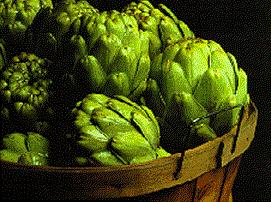 Start with seeds 8 weeks before the last estimated frost date in your area. Sow them ¼ inch apart and ¼ inch deep. Depending on your region, you may be able to leave them outside in the fall and winter. If you live in a colder region, you may have to bring them in for the winter.
Start with seeds 8 weeks before the last estimated frost date in your area. Sow them ¼ inch apart and ¼ inch deep. Depending on your region, you may be able to leave them outside in the fall and winter. If you live in a colder region, you may have to bring them in for the winter.
